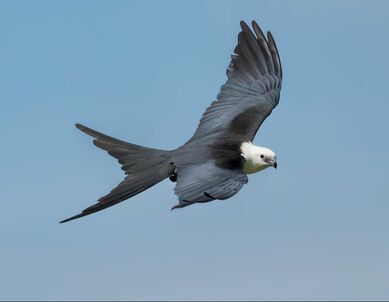Kite nests are like GOLD for their value to ARCI’s conservation research.
Why study nesting Swallow-tailed Kites?

Avian Research and Conservation Institute (ARCI) has monitored nesting Swallow-tailed Kites in the southeastern United States since 1988. We have learned a great deal by following the fate of hundreds of nests, mostly on public conservation lands and commercial timber lands. These data are being used to spread awareness, shape management plans, and inform conservation action. Over the years, we have discovered (and heard from you) that more Swallow-tailed Kites are nesting in urban and suburban landscapes.
Archiving specific nest locations and the fates of each of these nests is truly valuable for this charismatic species, which has experienced large variations in population size and distribution over the century. We can determine the protective status and potential threats to each nest site or neighborhood of nests and advise land owners, whether private, public, or commercial, on how best to protect them. We also can identify areas where productivity is particularly high or low and, over time, relate this to factors such as site fidelity, longevity, abandonment, predation and disturbance risks, and habitat integrity through long-term monitoring.
Potential funding is scarce for such studies, no matter how vital the results are for enduring management and conservation of imperiled species. Furthermore, ARCI’s staff cannot be in all places at once. However, YOU can help immensely by reporting kite behavior that may indicate nesting. The materials in Nest Finding Tips is there to guide you in finding and safely monitoring Swallow-tailed Kite nests.
Not surprisingly, however, Swallow-tailed Kite nest sites do not all contribute equally to population sustainability. As we have discovered, predation by Great Horned Owls (Bubo virginianus) on nesting Swallow-tailed Kites and their young is the most significant threat to the species’ nesting success and productivity. Great Horned Owls prefer open woodlands, swamps, and agricultural areas, but can be found in a variety of habitats – including those in which Swallow-tailed Kites nest. However, Great Horned Owls may be relatively rare in urban and suburban areas of Florida. Therefore, it would be very important to learn if there are differences in nest success and productivity between such developed areas and more natural landscapes (e.g., conservation lands) and timberlands (which structurally mimic natural nesting habitats in important ways). We would like to document Great Horned Owl numbers in developed landscapes versus public conservation lands and commercial timber lands. Furthermore, are Swallow-tailed Kites tolerating the increased disturbance associated with city life in return for more abundant and available prey and/or less exposure to Great Horned Owls?
We can gather the necessary data with your help in finding and monitoring Swallow-tailed Kite nests, and surveying for Great Horned Owls. This includes systematically noting when and where you hear vocalizing Great Horned Owls in relation to kite nesting areas, and collecting information on kite nesting success (the percentage of nests that fledge at least one juvenile) and productivity (the number of fledged young produced per nest in which eggs are laid). Together, these metrics will help us gauge the contributions of particular breeding sites and regions to the long-term sustainability of the U. S. population of Swallow-tailed Kites.
Now, go find a Kite!
